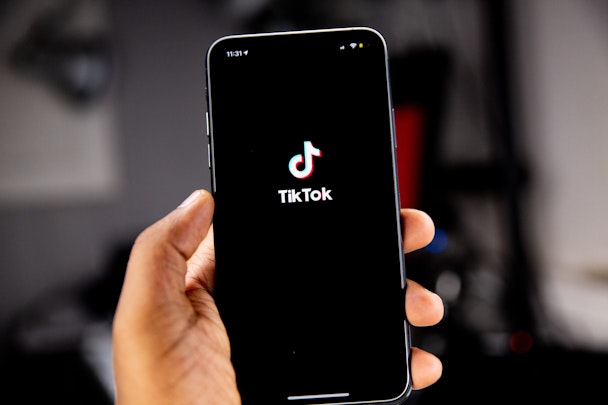If TikTok is becoming a hub for search, how can we minimize the spread of fake news?
Vertical video isn’t just about dance crazes and bizarre gen-alpha memes. Increasingly, users are turning to TikTok & co for news and search queries. No Brainer’s Alexandra Whiteside says we should be wary.

Does the rise of social search mean a rise in fake news, too? / Solen Feyissa via Unsplash
TikTok has surged in popularity since its worldwide launch in 2018 and is now used globally by brands, both small and large.
According to Statista, the video app is the sixth most popular social network worldwide with more than one billion monthly users – behind leaders Facebook (2.9 billion) and YouTube (2.5 billion).
As marketers, we’ve learned its advertising capabilities and its relevance to marketing strategies. And as TikTok steps up accessibility features, it’s becoming the ‘go-to’ for a wide array of user needs, from its shop to enhanced search engine features. It could certainly rise ahead of other social platforms in the not-too-distant future.
Just look at the influence of TikTok lingo used in everyday conversations – from 'TikTok made me buy it' to an array of hashtags, including channel-specific hashtags that include ‘Tok’ after popular search terms, like #BookTok and #FilmTok. You can’t walk down the streets without hearing ‘Did you see this on TikTok?’ That’s where the platform has nailed its audience: everyone wants to be in the know, rather than out the loop.
Prabhakar Raghavan, a Google senior vice president who runs the search giant’s knowledge and information organization even revealed that almost 40% of young users used TikTok or Instagram to look for a place to eat for lunch, instead of using Google Maps.
It’s clear that TikTok is being used more and more to consume information, with many of the younger generation using it as a search engine for a wide range of topics. With all this consumption of content through one social media platform, it begs the question, does TikTok really compare to a powerhouse such as Google?
Advertisement
Can TikTok hang with the search engine powerhouses?
The pressure of social search is being felt by even the heaviest of hitters in the search engine industry. But what does this mean for the long-standing search giants?
Well, it doesn’t mean that the top search engines such as Google and Bing will become obsolete. But it does create alternative possibilities for creators and influencers to create content that provides users with opinion-led recommendations, tips, and advice.
Google, with its real-time information and its breadth of data insights, will always outweigh the social app. Sure, this doesn’t stop gen Z from opting to search on the platform rather than booting up a browser. But not everything we consume on TikTok can be considered educational or informative, and we can’t always take it as a scout’s honor. The question we should really be asking is, how can we separate fact from the fake when we search on TikTok?
Advertisement
TikTok and the rise of ‘#fakenews’
The rise in searches for ‘fake news’ has increased by 50% since 2016, peaking particularly in 2017, 2018, and 2020. Can we align this sudden surge of popularity in the term to TikTok and the increased obsession with social media?
Based on Sensor Tower Data in 2022, TikTok came out on top for the most average daily minutes spent in-app, proving the power of its captivating user-generated content.
It’s easy to sink into a ‘TikTok hole’, with billions of videos at our fingertips, and determining the truth can seem much more difficult than on its efficient counterpart, Google.
TikTok is being used to search for much more comprising content, causing a media backlash. With more than 3.2bn views for #conspiracytheories, it can be deemed as a hub for falsified and fantasized realities that can cause harm and disruption in the real world.
In 2022, UK comms watchdog Ofcom found that TikTok was being used by 7% of adults to consume news (a dramatic increase from 1% in 2020), with half of this attributed to those aged 16 to 24.
Google has only double the number of users at 15%. In the 16 to 24 age range, TikTok is the sixth most-trusted source of news with 27% opting for this channel – a more than quadruple increase from 2020.
Another 2022 Ofcom report, on news consumption, revealed that young adults tended to use social media are their main new source consumption.
Suggested newsletters for you
The future of social search engines
With its easy-to-use search features, we’re all only one click away from a world of content by ungoverned creators. The increase of this medium as a search engine is arguably a given considering the increase in figures year-on-year. But how can platforms like TikTok ensure that the younger generation is aware of the ‘fake news’ they give a home to?
As we’re relying on these social apps for more than a simple scroll at the end of the working day, more time needs to be invested into removing fabricated and exaggerated content.
While we wait to see how TikTok overcomes these obstacles to build a safer, more informed online environment, we should proceed with caution.
Content by The Drum Network member:

No Brainer
We're an award-winning Digital PR, SEO and Content agency that delivers data-led and results-driven creative campaigns which really work.
Find out more
